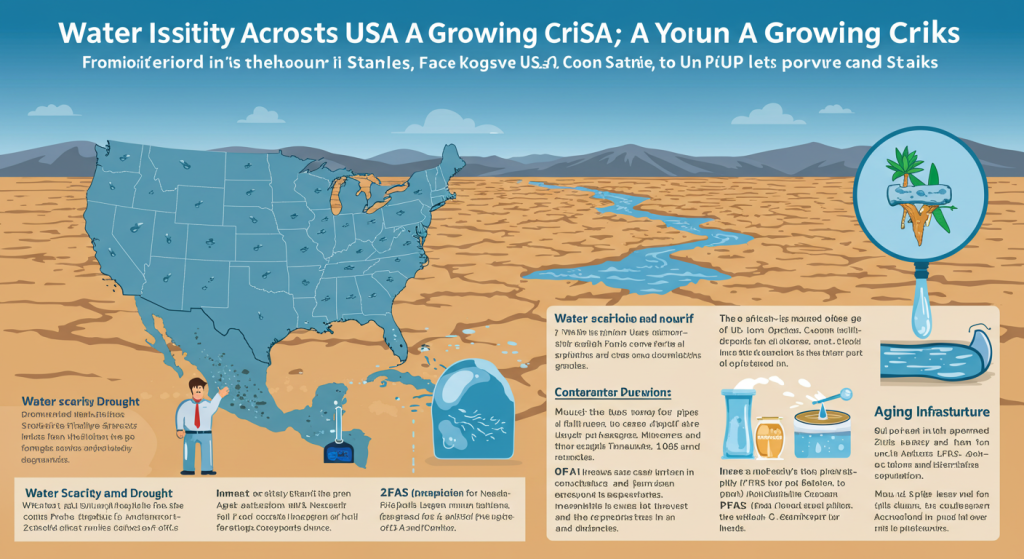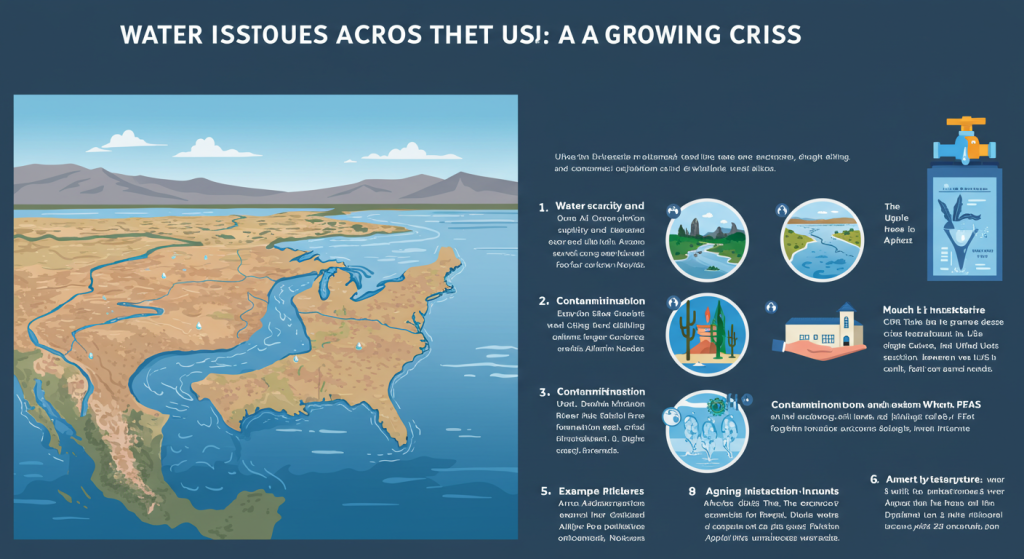Water is the lifeblood of communities, ecosystems, and economies, yet the United States faces mounting challenges in ensuring its availability, safety, and sustainability. From drought-stricken regions to aging infrastructure and contamination scandals, water issues are a pressing concern that demands attention. Let’s dive into the major water-related challenges across the country and explore what’s at stake.

1. Water Scarcity and Drought
In the Western United States, prolonged droughts have strained water supplies, particularly in states like California, Arizona, and Nevada. The Colorado River, a critical water source for millions, is at historic lows, with reservoirs like Lake Mead and Lake Powell dwindling. According to the U.S. Drought Monitor, over 40% of the U.S. experienced moderate to exceptional drought conditions in 2024, impacting agriculture, urban water supplies, and hydropower generation.
- Impact: Farmers face crop losses, cities impose strict water restrictions, and ecosystems suffer as rivers and wetlands dry up.
- Example: In 2023, Arizona announced cuts to water allocations for farmers due to the Colorado River’s depletion, forcing tough choices between food production and urban needs.
2. Contamination and Water Quality
Water contamination remains a significant issue, with high-profile cases like Flint, Michigan, exposing systemic failures. Lead, PFAS (forever chemicals), and agricultural runoff pollute drinking water in both urban and rural areas. The EPA estimates that 63 million Americans were exposed to unsafe drinking water between 2015 and 2024.
- Health Risks: Contaminants like lead can cause developmental issues in children, while PFAS are linked to cancer and immune system disorders.
- Example: In 2024, testing in several Midwest states revealed PFAS contamination in groundwater, prompting calls for stricter federal regulations.
3. Aging Infrastructure
Much of the U.S. water infrastructure—pipes, treatment plants, and dams—was built decades ago and is nearing the end of its lifespan. The American Society of Civil Engineers gave the nation’s water infrastructure a C- grade in 2021, citing frequent pipe breaks and water loss. An estimated 6 billion gallons of treated water are lost daily due to leaks.
- Economic Cost: Upgrading infrastructure could cost over $1 trillion over the next 20 years, a burden that often falls on local governments and ratepayers.
- Example: In 2023, Jackson, Mississippi, faced a water crisis when its treatment plant failed, leaving 150,000 residents without safe drinking water for weeks.
4. Climate Change and Extreme Weather
Climate change exacerbates water issues through unpredictable weather patterns. Floods overwhelm outdated stormwater systems, while hurricanes and heavy rains contaminate water supplies with sewage and debris. Conversely, extended dry spells reduce groundwater recharge, critical for rural communities.
- Regional Impact: Coastal states like Florida face saltwater intrusion into freshwater aquifers, while the Midwest grapples with flooding that disrupts water treatment.
- Example: Hurricane Helene in 2024 caused widespread flooding in the Southeast, leading to boil-water advisories in multiple counties.
5. Inequity in Access
Water access is not equal across the U.S. Rural and low-income communities, particularly Native American reservations, often lack reliable access to clean water. The Navajo Nation, for example, has thousands of households without running water, relying on hauled water or contaminated sources.
- Social Justice: These disparities highlight environmental justice issues, as marginalized communities bear the brunt of pollution and infrastructure neglect.
- Example: In 2024, advocacy groups pushed for federal funding to address water access gaps in rural Appalachia, where aging wells and septic systems fail regularly.

Paths Forward
Addressing these water issues requires coordinated action:
- Investment: Federal and state governments must prioritize funding for infrastructure upgrades and climate resilience.
- Regulation: Stronger enforcement of water quality standards, especially for emerging contaminants like PFAS, is critical.
- Innovation: Technologies like desalination, water recycling, and smart water management systems can help stretch limited supplies.
- Equity: Targeted investments in underserved communities can close access gaps and ensure clean water for all.
Conclusion
The water crisis in the USA is multifaceted, touching on environmental, economic, and social challenges. While the problems are daunting, they are not insurmountable. By raising awareness, advocating for policy changes, and embracing innovative solutions, we can secure a sustainable water future for all Americans. Let’s act before the well runs dry.
What are your thoughts on water issues in your community? Share below and let’s keep the conversation flowing!



